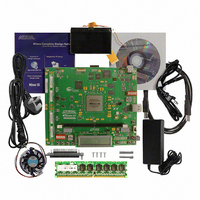DK-DEV-3SL150N Altera, DK-DEV-3SL150N Datasheet - Page 328

DK-DEV-3SL150N
Manufacturer Part Number
DK-DEV-3SL150N
Description
KIT DEVELOPMENT STRATIX III
Manufacturer
Altera
Series
Stratix® IIIr
Type
FPGAr
Datasheets
1.EP3SL150F780C4N.pdf
(16 pages)
2.EP3SL150F780C4N.pdf
(332 pages)
3.DK-DEV-3SL150N.pdf
(34 pages)
Specifications of DK-DEV-3SL150N
Contents
Development Platform, Cables and Software
Silicon Manufacturer
Altera
Core Architecture
FPGA
Core Sub-architecture
Stratix
Silicon Core Number
EP3S
Silicon Family Name
Stratix III
Kit Contents
Development Board, Cable And Accessories
Rohs Compliant
Yes
For Use With/related Products
EP3SL150F152
Lead Free Status / RoHS Status
Lead free / RoHS Compliant
Other names
544-2568
Available stocks
Company
Part Number
Manufacturer
Quantity
Price
Company:
Part Number:
DK-DEV-3SL150N
Manufacturer:
Altera
Quantity:
135
- Current page: 328 of 332
- Download datasheet (4Mb)
1–328
Table 1.
Stratix III Device Handbook, Volume 2
Glossary Table (Part 3 of 4)
Letter
S
T
U
to-channel-skew)
TCCS (channel-
Referenced I/O
SW (sampling
Single-ended
t
t
Standard
O U T P J _ D C
window)
O U T P J _ I O
Voltage
Subject
t
t
t
t
IN C C J
D U T Y
F A L L
R I S E
—
t
C
The period of time during which the data must be valid in order to capture it correctly. The
setup and hold times determine the ideal strobe position within the sampling window (the
following figure):
Timing Diagram
The JEDEC standard for SSTl and HSTL I/O standards defines both the AC and DC input
signal values. The AC values indicate the voltage levels at which the receiver must meet its
timing specifications. The DC values indicate the voltage levels at which the final logic state of
the receiver is unambiguously defined. After the receiver input has crossed the AC value, the
receiver changes to the new logic state.
The new logic state is maintained as long as the input stays beyond the DC threshold. This
approach is intended to provide predictable receiver timing in the presence of input waveform
ringing (The following figure):
Single-Ended Voltage Referenced I/O Standard
High-Speed receiver/transmitter input and output clock period.
The timing difference between the fastest and slowest output edges, including t
and clock skew, across channels driven by the same PLL. The clock is included in the TCCS
measurement (refer to the Timing Diagram figure under S in this table)
High-Speed I/O Block: Duty cycle on high-speed transmitter output clock.
Timing Unit Interval (TUI)
The timing budget allowed for skew, propagation delays, and data sampling window. (TUI =
1/(Receiver Input Clock Frequency Multiplication Factor) = t
Signal high-to-low transition time (80-20%)
Cycle-to-cycle jitter tolerance on PLL clock input
Period jitter on general purpose I/O driven by a PLL
Period jitter on dedicated clock output driven by a PLL
Signal low-to-high transition time (20-80%)
V
V
OH
OL
0.5 x TCCS
Chapter 1: Stratix III Device Datasheet: DC and Switching Characteristics
RSKM
Definitions
Sampling Window
V
Bit Time
REF
(SW)
—
RSKM
C
/w)
V
V
© July 2010 Altera Corporation
IH(DC)
IL(DC)
0.5 x TCCS
V
V
IH ( AC )
IL(AC )
V
CCIO
V
co
SS
variation
Glossary
Related parts for DK-DEV-3SL150N
Image
Part Number
Description
Manufacturer
Datasheet
Request
R

Part Number:
Description:
KIT DEV ARRIA II GX FPGA 2AGX125
Manufacturer:
Altera
Datasheet:

Part Number:
Description:
KIT DEV CYCLONE III LS EP3CLS200
Manufacturer:
Altera
Datasheet:

Part Number:
Description:
KIT DEV STRATIX IV FPGA 4SE530
Manufacturer:
Altera
Datasheet:

Part Number:
Description:
KIT DEV FPGA 2AGX260 W/6.375G TX
Manufacturer:
Altera
Datasheet:

Part Number:
Description:
KIT DEV MAX V 5M570Z
Manufacturer:
Altera
Datasheet:

Part Number:
Description:
KIT DEV STRATIX V FPGA 5SGXEA7
Manufacturer:
Altera
Datasheet:

Part Number:
Description:
KIT DEVELOPMENT STRATIX IV
Manufacturer:
Altera
Datasheet:

Part Number:
Description:
KIT DEV ARRIA GX 1AGX60N
Manufacturer:
Altera
Datasheet:

Part Number:
Description:
KIT STARTER CYCLONE IV GX
Manufacturer:
Altera
Datasheet:

Part Number:
Description:
KIT DEVELOPMENT STRATIX IV
Manufacturer:
Altera
Datasheet:

Part Number:
Description:
CPLD, EP610 Family, ECMOS Process, 300 Gates, 16 Macro Cells, 16 Reg., 16 User I/Os, 5V Supply, 35 Speed Grade, 24DIP
Manufacturer:
Altera Corporation
Datasheet:

Part Number:
Description:
CPLD, EP610 Family, ECMOS Process, 300 Gates, 16 Macro Cells, 16 Reg., 16 User I/Os, 5V Supply, 15 Speed Grade, 24DIP
Manufacturer:
Altera Corporation
Datasheet:











